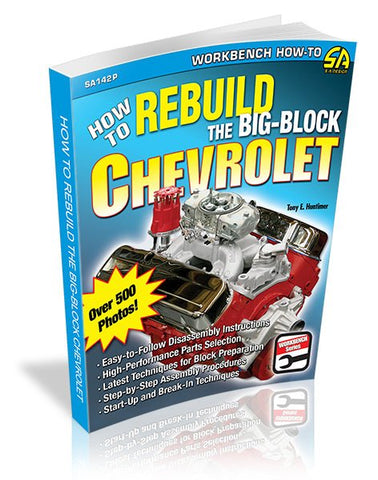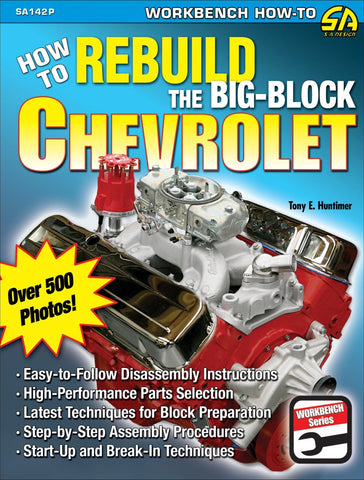The Mark IV Chevrolet big-block, made from 1965 to 1976, produced legendary performance and is one of the greatest big-blocks of all time. This design was a giant performance leap ahead of the old Chevy wedge big-block. The Mark IV featured canted valves, large intake ports, and an efficient head design for vastly increased air/fuel flow, better combustion, and huge horsepower. With a big-block under the hood, the Camaro, Chevelle, Corvette, and other Chevys became some of the most desirable ultra-high-performance cars of all time. How to Rebuild the Big-Block Chevrolet covers the best techniques for rebuilding the renowned 366-, 396-, 402-, 427-, and 454-ci big-block engines.
With exceptional clarity and insightful detail, this book explains engine removal, disassembly, parts inspection, selection of machine work, initial and final assembly, tuning, and break-in.
Through 500 photos and extremely detailed instruction, each step-by-step procedure explains professional techniques for rebuilding these engines. In addition, high-performance upgrades are covered as well as torque specs for major components, setting cylinder firing order, main bearing cap torque sequence, and much more. This volume provides an unparalleled level of information for rebuilding a big-block Chevy, so your rebuild project is hassle-free and successful.
Acknowledgments
What is a Workbench Book?
Chapter 1 Historical Review of the Big-Block Chevrolet
Parts Identification
What’s a 402 and What’s a 400 Big-Block?
Blocks
Cylinder Heads
Spark Plugs
Crankshaft
Chapter 2 Tools
Engine Stand
Engine Lifting
Basic Hand Tools
Best Tools for the Job
Required Miscellaneous Tools
Specialty Tools
Air Tools
Supplies
Lubricants
Engine Lubricant Options
Bolt Thread Lubricants and Sealers
Sealants
Cleaning Equipment
Chapter 3 Removal and Tear Down
Documentation
Safety Warnings
Drain Fluids
Air Conditioning
Fuel System
Wiring and Hoses
Distributor
Belts
Spark Plugs
Exhaust
Carburetor
Transmissions
Pulling Engine
Tear Down Long Block
Chapter 4 Inspection
Visual Inspection
Block
Heads
Crankshaft
Rods
Harmonic Damper
Chapter 5 Selecting Parts
Got Performance?
Aftermarket Blocks
Main Cap Conversion
Bearings
Rotating Assembly
Induction
Heads
Valvetrain
Oiling System
Oil Pans
Windage Tray
Gaskets
Fasteners
Cooling System
Fuel System
Chapter 6 Machine Shops
Pre-Machine-Shop Planning
Machine to Application Requirements
Pre-Machine-Shop Tasks
Professional Inspection
Machine Shop Services
Block
Heads
Rotating Assembly
Intake Manifold and Head Fitment
General Machine Shop Services
Chapter 7 Cleaning
Safety First!
Tools and Cleaning Items
Engine Cleaning Brushes
Chemical Dip Cleaner
Compressed Air
Pressure Washer
Cleaning Area
Critical Cleaning Details
Step-by-Step Engine Cleaning Process
Chapter 8 Pre-Assembly
Inventory
Inspection
Hydraulic Problems
Clean up Your Act
Head Games
Step-by-Step Pre-Assembly
Chapter 9 Step-by-Step Final Assembly
Chapter 10 Start-Up
Lubrication
Coolant
Throttle
Wires and Hoses
Grounds
Accessories and Belts
Fuel
Battery
Pre-Oil Engine
Distributor Reset
Transmission
Initial Timing
Pick Up Your Mess
Flat Tappet Cam Break-In Process
Fire It Up!
Roller Cam Break-In
Camshaft Break-In
Break In the Rest
Tuning
Appendix A: Torque Reference
Appendix B: Work-Along Sheets
Source Guide
The Mark IV Chevrolet big-block, made from 1965 to 1976, produced legendary performance and is one of the greatest big-blocks of all time. This design was a giant performance leap ahead of the old Chevy wedge big-block. The Mark IV featured canted valves, large intake ports, and an efficient head design for vastly increased air/fuel flow, better combustion, and huge horsepower. With a big-block under the hood, the Camaro, Chevelle, Corvette, and other Chevys became some of the most desirable ultra-high-performance cars of all time. How to Rebuild the Big-Block Chevrolet covers the best techniques for rebuilding the renowned 366-, 396-, 402-, 427-, and 454-ci big-block engines.
With exceptional clarity and insightful detail, this book explains engine removal, disassembly, parts inspection, selection of machine work, initial and final assembly, tuning, and break-in.
Through 500 photos and extremely detailed instruction, each step-by-step procedure explains professional techniques for rebuilding these engines. In addition, high-performance upgrades are covered as well as torque specs for major components, setting cylinder firing order, main bearing cap torque sequence, and much more. This volume provides an unparalleled level of information for rebuilding a big-block Chevy, so your rebuild project is hassle-free and successful.
Acknowledgments
What is a Workbench Book?
Chapter 1 Historical Review of the Big-Block Chevrolet
Parts Identification
What’s a 402 and What’s a 400 Big-Block?
Blocks
Cylinder Heads
Spark Plugs
Crankshaft
Chapter 2 Tools
Engine Stand
Engine Lifting
Basic Hand Tools
Best Tools for the Job
Required Miscellaneous Tools
Specialty Tools
Air Tools
Supplies
Lubricants
Engine Lubricant Options
Bolt Thread Lubricants and Sealers
Sealants
Cleaning Equipment
Chapter 3 Removal and Tear Down
Documentation
Safety Warnings
Drain Fluids
Air Conditioning
Fuel System
Wiring and Hoses
Distributor
Belts
Spark Plugs
Exhaust
Carburetor
Transmissions
Pulling Engine
Tear Down Long Block
Chapter 4 Inspection
Visual Inspection
Block
Heads
Crankshaft
Rods
Harmonic Damper
Chapter 5 Selecting Parts
Got Performance?
Aftermarket Blocks
Main Cap Conversion
Bearings
Rotating Assembly
Induction
Heads
Valvetrain
Oiling System
Oil Pans
Windage Tray
Gaskets
Fasteners
Cooling System
Fuel System
Chapter 6 Machine Shops
Pre-Machine-Shop Planning
Machine to Application Requirements
Pre-Machine-Shop Tasks
Professional Inspection
Machine Shop Services
Block
Heads
Rotating Assembly
Intake Manifold and Head Fitment
General Machine Shop Services
Chapter 7 Cleaning
Safety First!
Tools and Cleaning Items
Engine Cleaning Brushes
Chemical Dip Cleaner
Compressed Air
Pressure Washer
Cleaning Area
Critical Cleaning Details
Step-by-Step Engine Cleaning Process
Chapter 8 Pre-Assembly
Inventory
Inspection
Hydraulic Problems
Clean up Your Act
Head Games
Step-by-Step Pre-Assembly
Chapter 9 Step-by-Step Final Assembly
Chapter 10 Start-Up
Lubrication
Coolant
Throttle
Wires and Hoses
Grounds
Accessories and Belts
Fuel
Battery
Pre-Oil Engine
Distributor Reset
Transmission
Initial Timing
Pick Up Your Mess
Flat Tappet Cam Break-In Process
Fire It Up!
Roller Cam Break-In
Camshaft Break-In
Break In the Rest
Tuning
Appendix A: Torque Reference
Appendix B: Work-Along Sheets
Source Guide










